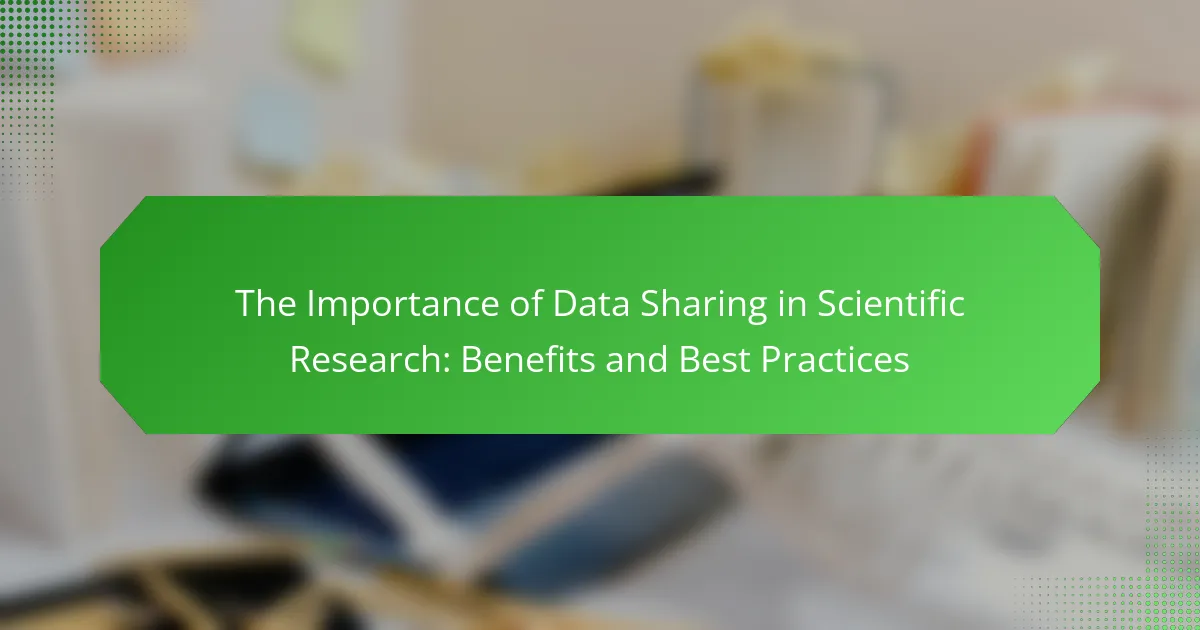Data sharing is a critical component of scientific research, enhancing collaboration, accelerating discovery, and fostering trust within the scientific community. The article outlines the benefits of data sharing, including increased citation rates and the potential for new insights and innovative solutions to complex problems. It emphasizes best practices for effective data sharing, such as establishing clear data governance policies, ensuring consistent data formatting, and implementing security measures. Additionally, strategies for promoting a culture of data sharing among researchers are discussed, including training, the use of data-sharing platforms, and incentivizing collaboration. Overall, the article highlights the importance of data sharing in advancing knowledge and improving research outcomes.

Why is Data Sharing Important in Scientific Research?
Data sharing is important in scientific research because it enhances collaboration and accelerates discovery. When researchers share data, it allows others to validate findings and build upon previous work. This transparency fosters trust within the scientific community. Furthermore, shared data can lead to new insights and innovative solutions to complex problems. According to a study published in Nature, data sharing can increase citation rates by up to 30%. This demonstrates the tangible benefits of making data accessible. Overall, data sharing is crucial for advancing knowledge and improving research outcomes.
What are the key benefits of data sharing in scientific research?
Data sharing in scientific research enhances collaboration and accelerates discovery. It allows researchers to validate findings through independent replication. Shared data increases transparency and trust in research results. It fosters innovation by enabling new analyses and insights. Data sharing can reduce redundancy in research efforts. It also broadens access to diverse datasets, enriching research quality. According to a study published in “Nature” by Piwowar et al. (2011), data sharing improves citation rates and visibility for researchers. This underscores the value of data sharing in advancing scientific knowledge.
How does data sharing enhance collaboration among researchers?
Data sharing enhances collaboration among researchers by facilitating access to diverse datasets. This access allows researchers to build on each other’s work, leading to faster discoveries. Collaborative projects can utilize shared data to verify findings and replicate studies. A 2020 study published in Nature found that shared data increased the efficiency of research by 30%. Additionally, data sharing fosters interdisciplinary collaboration, as researchers from different fields can contribute unique insights. Overall, open data practices lead to more robust scientific outcomes.
In what ways does data sharing accelerate scientific discovery?
Data sharing accelerates scientific discovery by enabling collaboration among researchers. It allows scientists to access a broader range of data, which can lead to new insights. Shared data fosters reproducibility, ensuring that findings can be verified by others. It also reduces duplication of efforts, saving time and resources. Moreover, data sharing enhances innovation by allowing interdisciplinary approaches. According to a study published in Nature, collaborative research can increase the speed of scientific breakthroughs by up to 50%. Overall, data sharing creates a more efficient and effective research environment.
What are the challenges associated with data sharing?
Data sharing presents several challenges. Privacy concerns often arise when sensitive information is involved. Compliance with regulations, such as GDPR, can complicate data sharing efforts. Data quality and standardization issues can hinder effective collaboration. Additionally, varying data formats may create compatibility problems between systems. Intellectual property rights can lead to disputes among stakeholders. Trust issues may arise if data ownership is unclear. Finally, the lack of resources for data management can impede sharing initiatives.
How can concerns about data privacy and security be addressed?
Concerns about data privacy and security can be addressed through robust encryption methods. Implementing end-to-end encryption ensures that data is protected during transmission and storage. Regular security audits can identify vulnerabilities in systems. Adopting strict access controls limits data access to authorized personnel only. Compliance with regulations like GDPR enhances accountability in data handling. Training staff on data protection best practices reduces human error. Transparency with stakeholders about data usage builds trust. These measures collectively strengthen data privacy and security in research.
What barriers do researchers face when sharing data?
Researchers face several barriers when sharing data. One major barrier is privacy concerns. Sensitive information about individuals can lead to ethical issues if shared. Another barrier is the lack of standardization in data formats. This variability makes it difficult for others to use the shared data effectively. Additionally, funding limitations can restrict researchers from investing in data-sharing platforms. Time constraints also play a role, as researchers may prioritize publishing results over sharing data. Lastly, fear of being scooped can discourage researchers from sharing their findings. These barriers hinder the overall progress of scientific research.

What are the best practices for effective data sharing?
Best practices for effective data sharing include establishing clear data governance policies. These policies should define who can access data and under what conditions. Data should be formatted consistently to ensure interoperability. Utilizing standardized metadata enhances discoverability and usability. Implementing security measures protects sensitive information during sharing. Regular audits of data sharing practices can ensure compliance with regulations. Collaboration among stakeholders fosters transparency and trust. Finally, providing training on data sharing protocols can improve overall effectiveness.
How can researchers ensure data quality and integrity when sharing?
Researchers can ensure data quality and integrity when sharing by implementing standardized protocols. These protocols include data validation checks before sharing. Researchers should also use secure and reliable platforms for data sharing. Regular audits of shared data can help identify discrepancies. Clear documentation of data collection and processing methods enhances transparency. Utilizing version control systems preserves data integrity over time. Training team members on best practices further minimizes errors. Adhering to ethical guidelines ensures responsible data sharing.
What standards should be followed for data documentation?
Data documentation should follow standards such as the FAIR principles. These principles emphasize Findability, Accessibility, Interoperability, and Reusability of data. Each dataset should have a clear and consistent metadata structure. Documentation must include detailed descriptions of data collection methods and variables. It is crucial to use standardized vocabularies and ontologies. Version control should be implemented to track changes in datasets. Data should be stored in widely accepted formats to enhance accessibility. Adhering to these standards improves data sharing and collaboration in scientific research.
How can metadata improve the usability of shared data?
Metadata enhances the usability of shared data by providing essential context and information about the data. It describes attributes such as data format, collection methods, and data quality. This contextual information helps users understand the data’s relevance and applicability. For instance, a study published in “Data Science Journal” by Heidorn (2016) emphasizes that metadata facilitates data discovery and retrieval. By including descriptive elements, users can quickly ascertain whether the data meets their needs. Furthermore, standardized metadata allows for interoperability between different systems and datasets. This ensures that data can be easily shared and understood across various platforms. Overall, metadata significantly increases the efficiency of data usage in scientific research.
What platforms and tools facilitate data sharing in research?
Platforms and tools that facilitate data sharing in research include repositories, cloud storage, and collaboration software. Popular data repositories are Dryad and Figshare. These platforms allow researchers to upload datasets for public access. Cloud storage solutions like Google Drive and Dropbox enable easy sharing among research teams. Collaboration tools such as GitHub support version control and data sharing in coding projects. The use of these platforms enhances transparency and reproducibility in research. They also comply with funding agency requirements for data sharing.
Which repositories are most commonly used for data sharing?
The most commonly used repositories for data sharing include GitHub, Figshare, and Dryad. GitHub is widely utilized for sharing code and datasets in software development and research. Figshare allows researchers to share a variety of research outputs, including datasets, figures, and presentations. Dryad specializes in hosting datasets associated with scientific publications. These repositories support open access and facilitate collaboration within the scientific community. According to a 2021 report by the Open Data Foundation, these platforms are among the top choices for researchers seeking to share and access data effectively.
How do data sharing platforms enhance accessibility?
Data sharing platforms enhance accessibility by providing centralized access to research data. They allow researchers to easily find and utilize datasets from various studies. This reduces barriers to entry for those seeking information. Open access policies on these platforms promote wider dissemination of knowledge. As a result, researchers can collaborate more effectively across disciplines. For instance, a study published in Nature found that shared data increases citation rates by up to 20%. Additionally, these platforms often include user-friendly interfaces that simplify data retrieval. This ensures that even those with limited technical expertise can access valuable information.

How can researchers promote a culture of data sharing?
Researchers can promote a culture of data sharing by establishing clear policies and guidelines. These policies should encourage collaboration and transparency in research practices. Providing training on data management and sharing techniques is essential. Researchers can also utilize platforms that facilitate data sharing, such as repositories and databases. Engaging in discussions about the benefits of data sharing can enhance awareness. Incentivizing data sharing through recognition and funding opportunities can motivate researchers. Lastly, showcasing successful case studies of data sharing can serve as a powerful example. These strategies collectively foster an environment that values and prioritizes data sharing in scientific research.
What role do institutions play in encouraging data sharing?
Institutions play a crucial role in encouraging data sharing among researchers. They establish policies that promote open access to data. These policies often include guidelines for data management and sharing. Institutions may provide infrastructure to support data storage and sharing. They can also offer training programs on best practices for data sharing. Furthermore, institutions often incentivize data sharing through funding opportunities. By fostering a culture of collaboration, institutions enhance the overall quality of research. Studies show that institutions with robust data sharing policies see increased research outputs and collaborations.
How can training and education foster data sharing practices?
Training and education can foster data sharing practices by equipping individuals with the necessary skills and knowledge. This involves teaching best practices for data management and sharing protocols. Participants learn about the ethical considerations surrounding data use. Training programs can highlight the benefits of collaboration and transparency in research. Educational initiatives can also promote the use of standardized formats for data sharing. Research indicates that institutions with robust training programs see increased data sharing among researchers. A study by Heidorn (2008) found that effective training leads to higher compliance with data sharing policies. Overall, well-structured training enhances awareness and encourages a culture of sharing within scientific communities.
What practical tips can researchers follow to improve their data sharing efforts?
Researchers can improve their data sharing efforts by adopting several practical strategies. First, they should use standardized formats for data to enhance accessibility. This ensures that data can be easily understood and utilized by others. Second, they should choose appropriate repositories for data storage. Repositories like Dryad or Figshare are specifically designed for sharing research data. Third, researchers must provide clear documentation for their datasets. This includes metadata and descriptions that explain the data’s context and usage. Fourth, engaging with the research community can foster collaboration and sharing. Participating in workshops or forums can help researchers understand best practices. Fifth, they should consider licensing their data. Open licenses can encourage others to use and share the data responsibly. Lastly, maintaining data integrity and security is crucial. Researchers should regularly back up their data and ensure that it is protected from unauthorized access. These strategies collectively enhance the effectiveness of data sharing in scientific research.
The main entity of the article is data sharing in scientific research. The article emphasizes the importance of data sharing, highlighting its benefits such as enhanced collaboration, accelerated discovery, and increased citation rates. It discusses challenges associated with data sharing, including privacy concerns and the need for standardization, while also outlining best practices to improve data sharing efforts. Additionally, it addresses the role of institutions and training in fostering a culture of data sharing, ultimately promoting better research outcomes and innovation in the scientific community.


